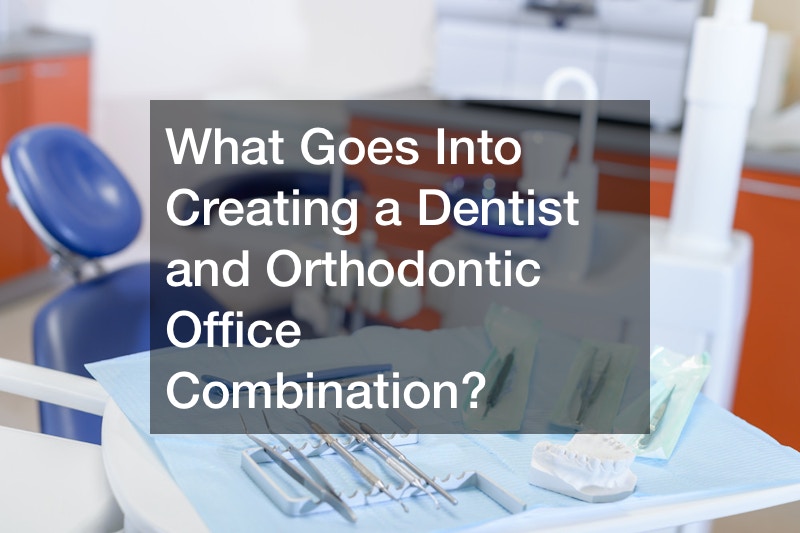
Flourishing in your dental career and running your practice is the goal for most dental professionals. Sometimes joining another professional like an orthodontist can help with the running expenses of the practice. An orthodontic office joined with a dental office is the perfect blend of dental chemistry for you and your new business partner.
Helping your patients maintain their teeth is something all of us professional dentists and orthodontists strive to achieve. Still, when running a business, the costs can be high, especially when the business is not already established with regular clients. The good news is that there are some good ways to merge your dental and orthodontic practices so each professional benefits.
Where is Your Current Practice Located?
Location, location, location are the words we often hear when watching a real estate show or simply what other realtors you’ve spoken to have already mentioned. The location is crucial because it will be a hot spot for potential patients or in a low-traffic area, meaning fewer clients walk through the door of your orthodontic practice. When it comes to running two types of practices in one, you may need different office solutions, one suited for the orthodontic office and one for the dentist.
Demographics are vital when finding the ideal location to set up a shop. For general dentistry, you may want to be in an accessible area with lots of traffic and perhaps with schools nearby and housing. General dentistry centered in a bustling city or suburbia is ideal as you can target families with school kids too.
Professional orthodontics can benefit from this location, too as children and adults could use your expert skills for their braces requirements. Will your dental practice feature cosmetic dentistry? If you aim to tackle cosmetic dental procedures, this would also affect where your practice is located. Upmarket areas with high-income residents are a great option in this regard too.
Plan Your Business Together
Working together on how you will manage the practice is a good way to stay on track with what’s happening all the time. Consider different scenarios that might negatively impact the business and think about solutions to resolve these issues. Think about the funds that are required to fuel the business, the expenses, marketing solutions, and promotions. Consider how many staff you’ll need to hire and their qualifications and tasks for the practice.
Merging for collaboration is one of the options dentists and orthodontists can consider, as this has benefits for both parties. The orthodontic office and dental practice will increase revenue and reduce expense costs.
Sharing Or Individual Options
Are you sharing office personnel?
Another aspect to consider when sharing a dental space with an orthodontic office is staff placement. Will you share the staff and thus also save as you’ll pay fewer people to man the administration and other facets of the business? Or, will each have your own staff to contend with?
You may offer custom construction service; the patient might need dental work and a series of orthodontics. They may need both dental branches to help improve their smile through custom construction, including cosmetic dentistry. Your staff should be trained and able to assist patients coming for various dental treatments.
Equipment Sharing
To some extent, you could share some of the machinery, especially the more expensive ones like the X-Ray machine. Often, only one machine of the sort is required in the practice since you won’t be using it simultaneously. Sharing computers at the front desk is also an option, especially when sharing staff. But other individual tools and personalized tools should each to their own as many dentists and orthodontists have preferences when it comes to tools.
Decide on equipment factors and, simultaneously, a budget can be set to purchase this dental practice equipment. Emergency dental services is something good to offer as a dental practice. As a team, you can decide whether you’re both up for the challenge, as many patients might need emergency dentistry.
Shared or Individual Insurance?
Like all the other aspects considered in your dentists office and orthodontic practice, you may need to consider insurance. You might choose to share or have individual insurance to cover things. Shared insurance must have a percentage for each party set in place, and each one will be responsible for it.
Your patients might come for a tooth cleaning service, and you’ll need the correct tools for your hygienist to use. Your insurance may cover the expense of certain tools or machinery when it needs repairs or replacement.
Don’t Choose Over the Top Right From the Get-Go – Instead, Start Small
If your budget is limited, you can choose to start with lower expectations. Start small, and don’t expect too much at the beginning. As the business gains recognition, it will become more and more popular within the community and, thus, more patients to have their teeth done.
Lower expenses also make it possible for you to provide affordable dental care and orthodontics to your patients. In these challenging times, everyone is looking to save in any way they can, and having market-compatible rates will help bring more patients to your practice.

Agree to Disagree – Conflict Resolutions
Every relationship has conflict, including business relationships. Can you and your partner resolve issues that pose conflict? There can be conflict about anything at any time, but resolving it or having a solution to resolve it is critical for the continued smooth functioning of the dentist’s office.
Market Your Dental Practice
When starting your co-dental practice adding an orthodontic office is great, but getting your practice’s name out to the public is something that needs additional work. If you and your business partner have just started together, marketing will greatly help get reach potential patients.
Offer Some Promotional Deals
Promos are always welcomed since everyone could benefit and enjoy saving or getting a deal. Even as a dental office, you can do special promotions that run for a period just to get those patients through the door. Some ideas for promotions can include a discounted polish and scale service, a special discount for seniors, and junior’s free checkups or extractions. There are so many you can do.
Use Social Media
Social media gets your message across really quickly. Use platforms like Facebook, Twitter, and YouTube to advertise. Many of the platforms are free to join, and you may pay a fee for premium extras like promoting your advert to the top of the page. The nice thing about social media for marketing your orthodontic office and dental services is that networks can continue sharing your posts and adverts, reaching even more people. These days you can hire a social media marketing agency to help you get your adverts and news out even faster.
Use Newsletters and Email Marketing Strategies
Take advantage of newsletters where you can share highlights of the month or use them as another opportunity to advertise. Email marketing with the use of newsletters and emails is an effective way to keep in touch with your patients.
Do Free Work for Charity
Charity work is also good to help get your practice out to the community. You can do free dental work for less fortunate areas of your area. Helping the local community is not something people easily forget, instead they may remember your practice and associate it with the work it does.
Create a Website
People are more trusting of businesses with websites as it gives them a degree of credibility. You can collaborate with a web design company or individual who can set your website up, listing all the information your patients need to learn about your practice, the services you offer, and your commitment to their dental health.
Ask Patients to Leave a Google Review
Online reviews impact consumers’ decisions to purchase or avoid a product in many ways. Since most people can access Google, they can read what others say about your business. It is a great way to get those positive little seeds planted that will later flourish into more patients looking for your expertise.

Tips for conflict resolution in your dental office
Try Not to Judge the Situation
When it comes to interests or weighing in on ideas, the one presenting the idea might feel personal about their idea and feel that it is important. Even if the idea seems unimportant to you, don’t dismiss them, as you would want them to take an interest in your ideas for the practice too. Consider how their idea could help because, at the end of the day, both you and your business partner are invested in the dental practice, and both of you bring strengths and contributions to make it work. Try to work on a plan where you both can meet halfway.
Use Listening to Your Benefit
Becoming a good listener can resolve many conflicts because it allows you to cool down your temper if something is upsetting. The United States Institute of Peace recommends “Active Listening” as a technique to diffuse conflict. The process involves listening and allowing the other person to talk, then responding in a manner meant to diffuse a disagreement.
Get Objective Help
Mediators are there to help businesses resolve disputes on many levels and this goes for medical practices too. The mediator is not biased towards one party or a situation, instead helps find an amicable solution so the business can carry on and operate without the same issue causing problems later.
What Are the Benefits of Combining a Dental and Orthodontic Practice?
Save Money
When merging your dentist and orthodontic office has many benefits, including saving money. Being business partners means that the financial expenses are shared and not divided into one person. It takes that weight off when the cost-of-living increases and everything else increases in price.
Lower Competition
Working in one practice will also reduce the competition within the same area because you and your business partner are now working together. Together you’re aiming for the same goals and face the same challenges, with the advantage of each other to lean on for support and ideas. With less competition, you’ll get more patients coming to your office instead.
Build Trust and a Stellar Reputation With Patients
Your patients would view the orthodontic office as a true dental facility since it offers general dentistry, cosmetic dentistry, and orthodontics. This image is very positive and will help boost positive reviews, support, and word-of-mouth.

Some Drawbacks of Combining Dentist and Orthodontic Practices
You’re Not the Sole Decision Maker
– Now that you have a business partner, you cannot decide independently. Instead, you must keep each other informed and agree on certain things together.
You Can’t Just Open and Close Your Office as You Please
– Being business partners also means some general rules apply to both parties. Perhaps if you had your own orthodontic office, you would close on certain days or spontaneously take a day off, letting your receptionist know you won’t be in, in case calls came through. But with a partner in the business, both would agree that trading hours are strictly on certain days. Or either one is to be at the practice undoubtedly on certain given days.
You Must Share the Revenue
– Working together means you’re sharing the income, and you may be in it 50/50 or have lower stakes than your business partner. Either way, the spoils are never solely for one party.
Everyone needs reliable dental care since our teeth are one of the most critical aspects of our mouths and the very start of digestion. Running out of clients is nearly impossible once you’ve already established your business in dentistry because everyone needs their teeth attended to. Having a 2-in-1 dental and orthodontic office will also make things convenient for your patients since they don’t have to go to another location to find an orthodontist. It also benefits you as expenses are reduced, and challenges are shared. It’s a convenient one-stop solution for your patients.



